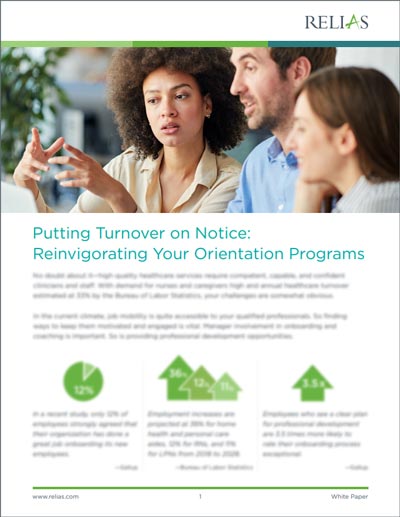As the workforce shortage continues to challenge post-acute care organizations, fresh-faced new hires may be entering the field for the first time. Creating an effective onboarding experience for employees new to healthcare is important if you want to retain your staff and build your team’s competence.
The COVID-19 pandemic accelerated the workforce shortage in many sectors, and post-acute care organizations are struggling to stay fully staffed. In 2021, the employee turnover rate reached 39.4% in the healthcare and social assistance industries, the U.S. Bureau of Labor and Statistics reported.
Finding employees to fill those gaps strains hiring managers and finances. Gallup estimates that the cost of replacing an employee can range from one-half to two times the employee’s annual salary.
As a post-acute care provider, you feel the pressure of a narrower prospect pool. When you fill your open slots by hiring employees new to the industry, you must ensure your onboarding processes not only include your organization’s specific policies but also wider regulations and evidence-based procedures. This challenge also presents an opportunity — to optimize your onboarding plans and ensure you’re hiring and retaining well-prepared employees.
Here are some best practices to help retain new hires and engage them with your organization.
Explain your way of doing things
Make sure new employees understand your expectations and the organization’s policies clearly. Provide site-specific and in-house trainings, and break them into short microlearning sessions to better reinforce learning and support retention.
Develop an effective onboarding process
A recent Relias webinar revealed that about 72% of healthcare participants indicated that their organization’s onboarding process is not dialed in, or optimized.
Is your organization’s onboarding dialed in?
Yes 28%
No 71.6%
One of the key drivers of turnover is poor onboarding. “People are coming to you not only for the paycheck, but they want to build themselves up,” said Relias Principal of Post-Acute Care Vince Baiera, BSN. “What do young people want? They want adequate support. They want to feel connected.”
Work on quarterly goals with your staff
For young employees in the workforce looking for immediate gratification, the annual review seems far off. During the first year, spending 10 minutes with each employee every quarter to set and review goals will clarify onboarding expectations and promote employee retention.
During the Relias webinar, only 28% of participants said they set and review quarterly goals with their employees.
How many of you (or your team) set and review quarterly goals with your staff?
We do 27.9%
We do not 72.1%
Dedicating time to discuss goals shows your employees that you value their success and want them in your organization for the long run.
Understand what employees love about healthcare
New employees like the satisfaction they get from the service they provide to patients and the feeling that they make a difference in the world. To fuel their confidence, share positive feedback from leaders, colleagues, and patients. Being an advocate for patients is another way they gain fulfillment from the job.
Relias Vitals+Vision Podcast
Listen as we sit down with Vince Baiera, Partner for Post-Acute Care at Relias, to discuss onboarding and retention in health care. Vince shares some best practices in hiring, training, and engaging employees to help retain them in the organization.
Talk with your employees and listen
You’ve probably heard that people don’t leave jobs — they leave bad managers. Employees lose trust when they feel their managers are disrespecting them or are incompetent.
“The reason that people feel that their leaders are incompetent is that they don’t understand the context of the decision,” said Baiera. “They don’t get the why behind what the decision was. Explaining the rationale and the motivation behind these decisions is what young people care about.”
Leaders can build trust by communicating openly with their employees and providing them opportunities to both talk and listen.
Find out what motivates your employees
With employees new to healthcare, look beyond the resume at their skills and goals.
In today’s job market, the average time in roles tends to be shorter than in the past. Rather than viewing short stints as job hopping, start a discussion about why they left their previous role and what’s important to them in this one.
Support their motivation by emphasizing the meaningful work they’ll do in your organization. Tell your story too. That can help build a strong relationship and inspire your new hire.
Continuously promote employee engagement
As your employees successfully move beyond onboarding, you’ll need to continue to promote employee engagement. Make it a strategic priority and work on it every day.
For example, you can take 30 minutes each day and walk the floor to hear how people are doing. They want to be heard and seen. Appreciate and recognize them publicly for their good work.
When clinicians gain competence and show promise, assign mentors who can help them climb the career ladder.
Taking this strategic approach will optimize the learning experience and provide extra support when onboarding employees new to healthcare. Helping new hires acclimate to the workplace culture from day one promotes staff retention and consistent, evidence-based care.

Putting Turnover on Notice: Reinvigorating Your Orientation Programs
High-quality healthcare services require competent, capable, and confident clinicians and staff. With annual healthcare turnover estimated at 33% by the Bureau of Labor Statistics, you need to be strategic about your onboarding and new hire orientation.
Download this research brief →





